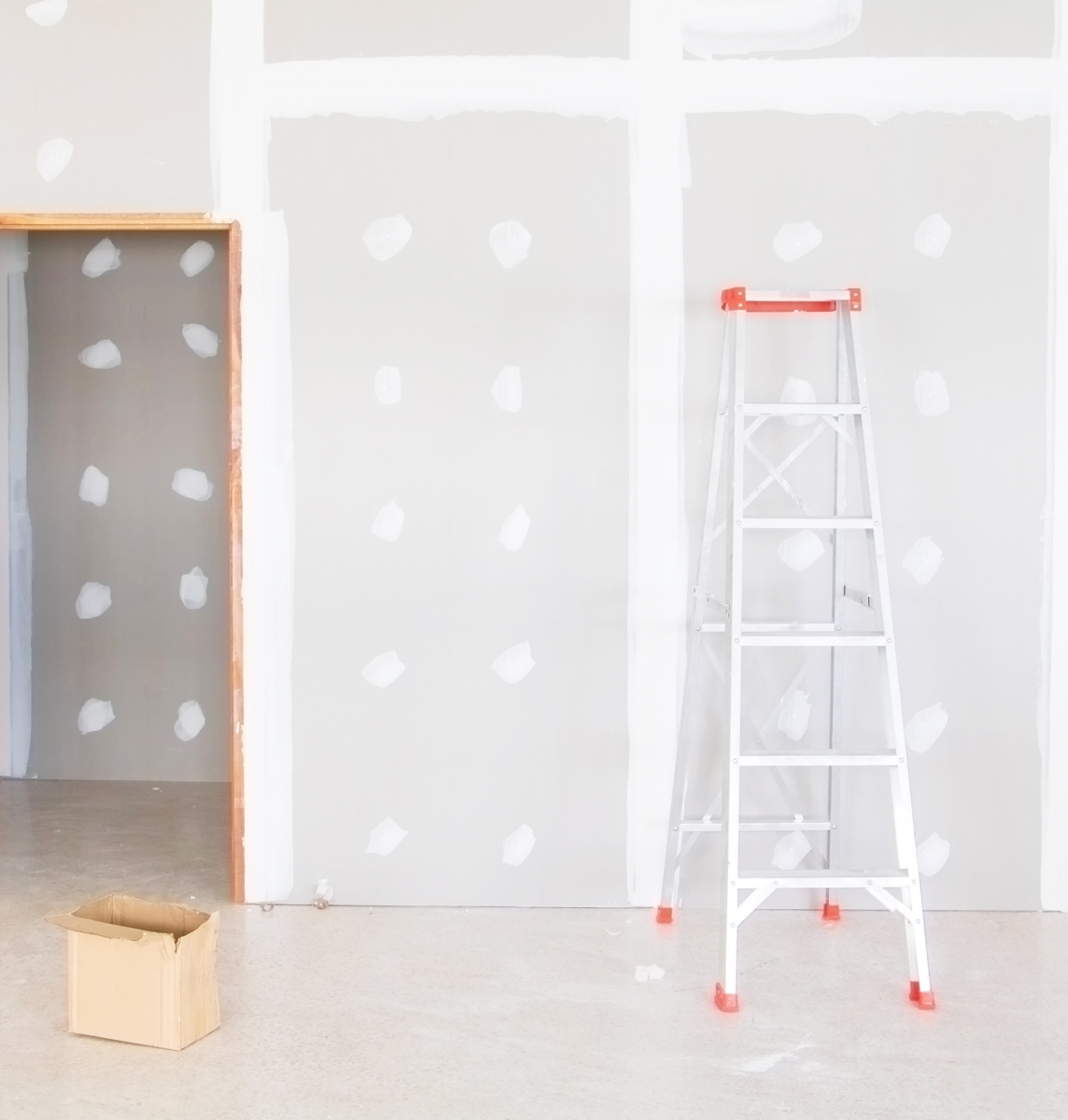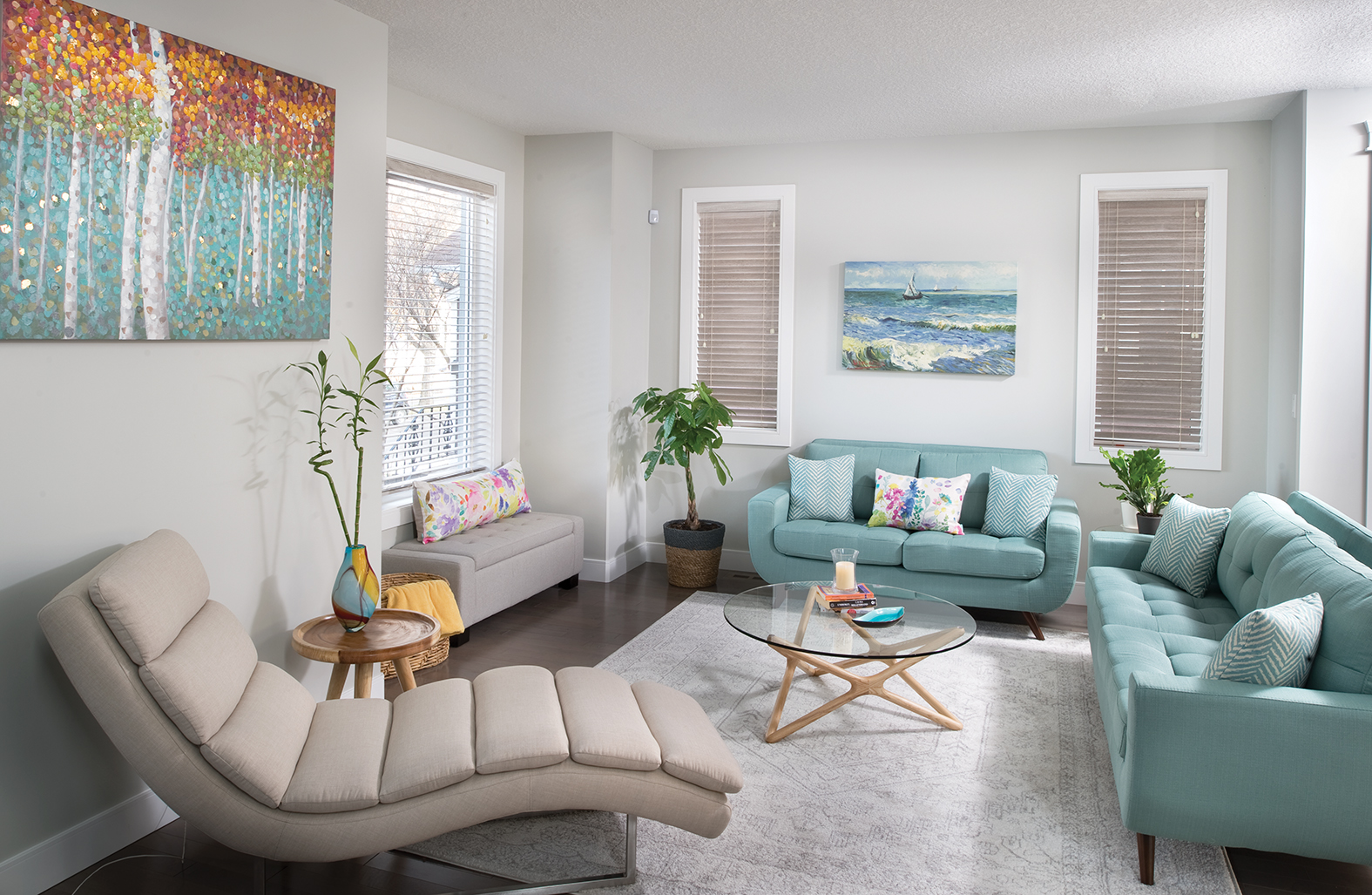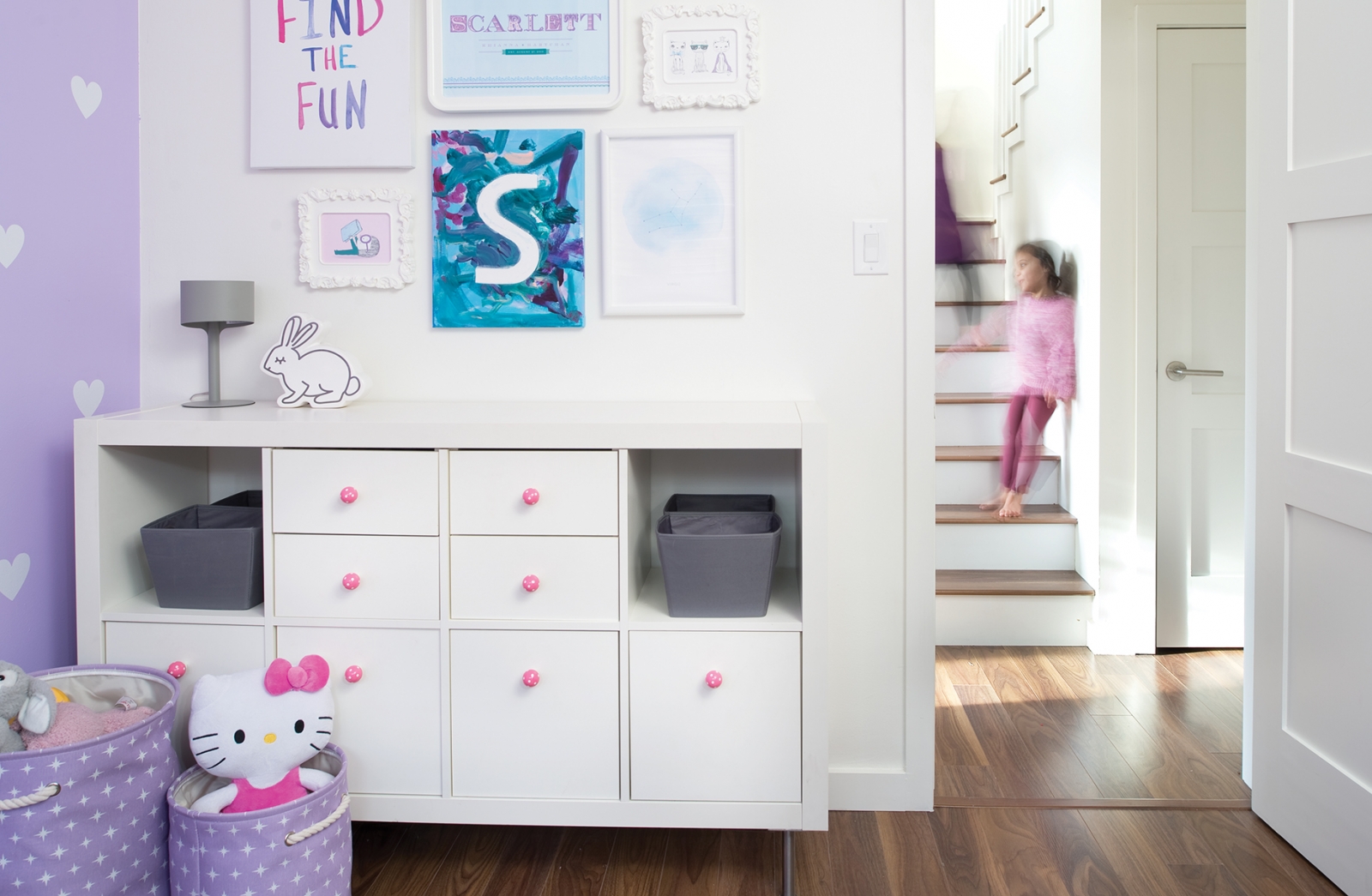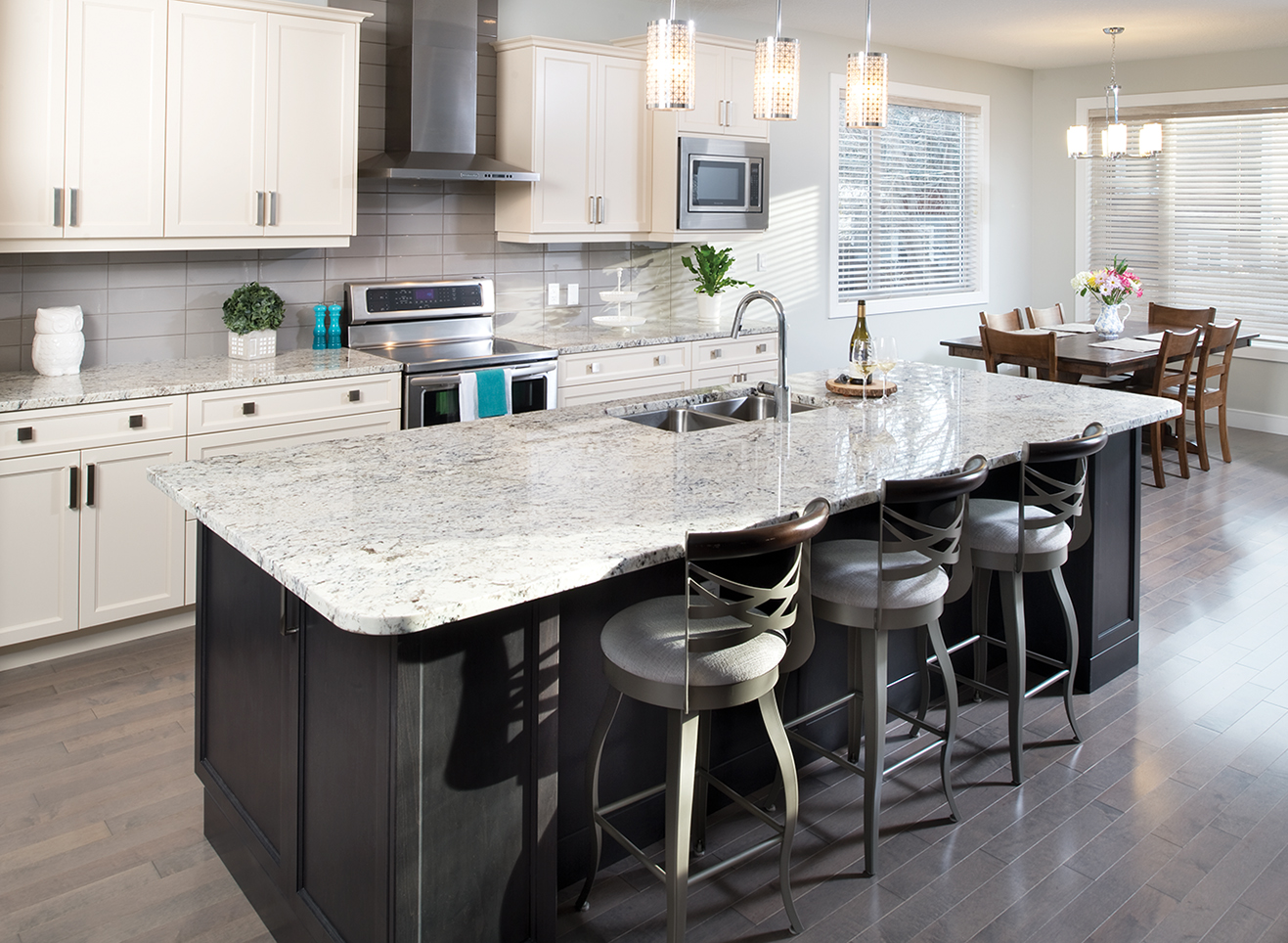Space with Form and Function
Making your home work for you is possible – without completely draining your patience or wallet.
Jenelle Gartner was looking at fixtures and furnishings for the renovation of her family’s late 1960s Parkview home and, suddenly, she felt overwhelmed. She could choose between a bright navy as an accent colour in her tiled backsplash, or go for a more subtle grey. She could rearrange the layout of the kitchen in several ways. She was torn between mid-century modern and an overall contemporary style.
Gartner is a graphic designer by trade, so she has a creative eye. But the big choices -from function to layout – weighed heavily on her mind as they carried large price tags, and she wanted the form and function to work with her two young children and their lifestyle. Gartner and her husband, Terence Harychan, knew that the older style of their home, with its divided living spaces and small kitchen, wasn’t going to work right away, so they made the changes before even moving into the house. They’d previously lived in a centrally located home, and were looking for a place they could renovate in an area that had good school options – the Parkview house was ideal.
As we all head through different stages of life, our living environment will need to evolve along with each of us, whether we’re moving in with a partner and consolidating years of furniture, making space for a new baby, converting rooms into different uses or downsizing as empty nesters. Navigating the big renovation decisions can be challenging, even for the most creative among us. photography by Bluefish Studios
Jenelle Gartner and Terence Harychan’s home interior design: Candace Wolfe of Candace Wolfe Designs; General Contractor: Revive Developments; Backsplash: River City Tile; Cabinets: DIY Cabinet Warehouse by Kitchen Craft
Thinking ahead
After her experience, Gartner advises hiring a designer to plan things out properly for a renovation. After struggling with the layout of her kitchen, she hired interior designer Candace Wolfe for a short consultation that expanded into Wolfe designing an overall floor plan.
“I basically took her plan and rebuilt it so it flowed better,” Wolfe says. Initially, the kitchen was more of a nook with all of the cabinets and appliances in one corner, but Wolfe knew Gartner would be making meals while watching the kids. So an open area with the placement of appliances switched made more sense. Now, there’s plenty of space to work in the kitchen with cabinets and workspace on an additional island, and it has an open, warm feeling that was absent in the initial design.
Wolfe says taking on a renovation like this one can be done by anyone, but it’s important that everyone in the home decides beforehand exactly what they want from the space. “If you’re a new couple moving in together, are you going to host dinner parties? Is it going to be like your retreat where you go because your regular day is so busy? Are you getting a dog or having kids?” Wolfe asks.
Jenna Pryor of Plum Home and Design, a retail store and interior design firm, agrees. “We like to have all the answers before we start swinging hammers, and before the dust starts flying, because the moment that happens, you have a crew on site [and] there’s pressure to make decisions – last-minute decisions can be very expensive,” says Pryor.
Once you make a decision around the purpose of a space, you can create concrete plans, deciding on what specifically needs to be done. Creating a design board that has all of the furniture, the colours and the fabrics is also a good idea to ensure that everything is coordinated.
Setting your priorities
It’s also a matter of prioritizing, since most people will not be able to do entire renovations or redesigns all at once. When Jillanna Sehn and her husband, Michael Shepherd, bought their first house together – moving from a 600 square-foot apartment to over 2,000 square feet – they had to decide what was most important to do first. They’d been law students up until recently and, until last year, never had the resources to purchase new furniture or design such a large space. Because their house was built in 2015, they don’t have many renovations to do, and instead are focusing on decor.
“When we first moved in, we were concerned mostly about function, everything from where the towel racks should be in the master bath to finding a larger sized bed,” says Sehn. “And now, we’ve been there a few months, so we’re starting to collect pieces that speak to us and fit with our colour scheme and style.”
They plan to be in this space for a long time, and, as a result, want the design choices to last, as well. The furniture they are purchasing now goes beyond the hand-me-down pieces they had in the past. A prime example is the kitchen table, handcrafted by Simply Amish Furniture, that Sehn says she hopes will become a family heirloom. “It’s a huge dining room, so we bought a big table to fit, and we love to entertain. We want this to be our forever table,” she says. Jillanna Sehn and Michael Shepherd’s home: Their decor is influenced by the granite and grey marble floors, while taking cues from the couple’s personalities. Builder: Bowen Homes; Table: Simply Amish Furniture
Keeping the future in mind
Longevity should also be at the forefront of a renovator’s mind even in spaces where the occupants themselves are rapidly changing – case in point, a nursery. Many people think of the baby’s room in terms of those early months; and it’s easy to get caught up in an industry catering to those looking for tiny furniture, cutesy cloud wallpaper and designer cribs.
Meanwhile, Wolfe says by keeping the room neutral it’s possible for the design to grow with the child, while maintaining its short-term functionality. Rather than buying furniture geared specifically to a baby, you should purchase items that will grow with the child such as full-size dressers that double as change tables, and regular book shelves. Colourful and fun elements can be added with books, mobiles, artwork on the walls or removable decals.
For empty nesters and those looking to age in their home, it’s also important to consider the future. Changes to the home can range from large-scale shifts of entire rooms so that places used most frequently are on the main floor – especially kitchens and bathrooms – to small fixes like adding easy-to-use hardware on cabinets. Extra lighting, non-slip flooring, sit-down showers and adjustable storage systems in garages can go a long way to making a home more age-appropriate. Some individuals look at taking down walls and opening up rooms in older homes to create more modern spaces that are easier to traverse.
The future should be a consideration even for those who don’t plan to stay in their homes long-term. For those looking to sell down the line, a renovation can add value to the home; while some think that means large scale or overly decorative changes need to be made, Pryor disagrees.
“I always talk about cost versus value,” says Pryor. “When you have a limited budget invest in the permanent foundation pieces first, decorative items can eat up your budget quickly but are easily added at a later date.”
And those useful elements do not have to be exceedingly costly either. Jenelle Gartner’s initial plan was to have custom-built storage lockers at her back doorway for her family, but she realized IKEA cabinets would work just as well. She took that idea one step further in her daughter’s room where she custom-designed a dresser from an IKEA bookshelf by adding drawers and colourful handles. It was inexpensive and she’s been using it for years – initially as a change table, and now as a place to store clothes.
Kitch, an Edmonton business owned by Andrew Hibbs, runs on that very concept – the idea of taking pre-fabricated IKEA units and custom-designing the doors and overlay to create unique looks. It’s a marriage between attractive design and functional pieces that can update a room for nearly half what it would cost to have it totally custom designed. It’s made kitchen cabinets, closet spaces and TV units with a final look completely different from anything in an IKEA showroom. Kitch’s own showroom is a testament; there, an IKEA kitchen cabinet unit has custom walnut doors and a custom-made wood extension of the countertop crafted by Wood Inc, Kitch’s sister company.
Hibbs says Kitch units are ideal for those wanting to renovate, knowing they may want to upgrade again in the future. He looks at the pieces as more akin to furniture rather than permanent fixtures in a home, since the units can be upgraded at any point with different colours or materials.
Now, several months post-renovation, Jenelle Gartner looks back at the process of renovating her own home wistfully, saying she actually misses it and looks forward to making more updates. In the end, it was an enjoyable creative outlet – but without a solid plan, the opposite could have happened.
Plan Ahead
A contingency fund:
Put aside extra money just in case unexpected expenses arise, especially with older homes. Wolfe has seen homes that weren’t properly insulated – one even had just rice inside. She also warns that renovations aren’t just what you see on home renovation TV shows. “I always say the magic doesn’t happen until after the commercial break. So, you see [something] on TV and think, wow, it’s so easy. But there’s a lot of behind-the-scenes stuff they just don’t show.”
Don’t just dig in:
Wolfe can share plenty of horror stories of clients who were suddenly motivated to start large renovations themselves. One couple started digging up their basement flooring and ended up with a hole that they left for four years as they were stumped as to how to address it. “We can fix it but, if you’re unsure, it’s best to just bring someone in who knows what they’re doing before hand,” Wolfe says.
True necessities:
You might think a designer crib for your baby is really beautiful; but is it really going to make a difference in the quality of your life? No, says Pryor, but a comfortable and versatile chair might. “I usually put that to the front of the list, because I have slept in that chair, I’ve spent countless hours in that chair, and even now when we’ve got older kids, we read books in that chair.”
Living arrangements:
For large-scale renovations, Wolfe and Pryor both recommend that homeowners think about how the renovation will affect their everyday lives. If it’s a kitchen renovation, maybe it’s best to do it in the summer so that meals can be done on the barbecue. “It’s our job to ask those questions, and prepare our clients for what that renovation’s going to look like,” Pryor says, “So, when it starts, they don’t think; ‘I had no idea’.”
Design Trends
How can you get the looks that are dominating magazines and Pinterest? “Year after year trends have been moving towards a more natural feel,” Cheryl Torrenueva, host of HGTV Canada’s Reno, Set Go! says. “There’s a big focus on wood finishes. Less rustic and industrial, more elegant, really celebrating the wood and artistic value that comes with celebrating the craftsmanship.” Next, add some greenery. “Plants help the air stay fresh and liven up a space, they prevent it from feeling stagnant,” says Torrenueva. Finally, add some marble print. Torrenueva recommends quartz countertops made to look like marble. “It’s durable and low maintenance, but you get this gorgeous look so it’s best of both worlds.”– Breanna Mroczek
Best Renovation Investments:
So you’re planning a big renovation and want to do it right – but what will get you the biggest bang for your buck? “I always recommend doing your research, instead of just going out to a big box store and buying what’s on sale,” says Torrenueva. “Favour long-term over instant savings, that’s always the way to go.”
Flooring:
“Get the look you want, but always consider the durability you need.” Torrenueva recommends and uses luxury vinyl planks. “People have no idea it’s vinyl: it looks like, and is priced like, a mid to high-end hardwood, but gives you more superior characteristics.”
Windows and Doors:
“Definitely invest in energy-efficient products that will prevent drafts and heat loss. You might not physically see a difference, but you’ll notice a difference on your energy bills.”
Appliances, hardware and fixtures:
“Invest in pieces that are durable and efficient and don’t require a lot of maintenance. Check the quality of materials too.”
Lighting:
“Go for LED lighting. It’s super trendy right now and will also decrease your electricity bills.”
– Breanna Mroczek
Invest in the Best
When talking to the experts, we’ve learned that investing in quality products and thinking long-term is smart when tackling renovation and decor projects. Appliances and furniture you’ll use over and over again – kitchen tables, sinks, countertops – are worth making sure they can stand regular use with little need for maintenance. When it comes to the kitchen, the Aga stove suits this need – these unique, custom-built cast iron cookers can be passed down from generation to generation, and they require low if any maintenance over their lifetimes.
“It’s part of our family, it’s like a heartbeat in our home,” says Faith Giesbrecht, the owner of Avenue Appliance, who’s been a proud owner of an Aga cooker for 12 years. “It makes your lifestyle much easier, people always tell me they can’t believe how much food I can make with it so quickly. My life is crazy and hectic, our house is full of young adults, we often have extra people living in our home. But the Aga helps with every aspect of cooking.”
What makes it so great? With a large oven capacity and multiple ovens with 10 different cooking methods – everything from baking to roasting to steaming – it replaces the need for smaller appliances like kettles, toasters and slow cookers.And, if you want to improve your cooking skills, the Aga can help. Because it’s made of cast iron and is left on continuously, “it holds the heat, and it’s a very radiant, gentle heat. Things don’t get overdone or burned easily, it’s very forgiving,” Giesbrecht says. – Breanna Mroczek
Colour Trends
According to Rosalyn Lazaruk of Wicket Blue Interiors, the shades trending for 2018 are darker, moodier colours. “Navy blue is a really strong neutral this year, it’s a bit warmer than black and gives an alternative to grey. Pair that with some of the mustard yellows or ochre colours, a lot of the deeper richer colours from nature.”Or, if you prefer a gentler palette, look to pastels. “We’re still seeing an influence of pastels – pale, soft, pretty colours. It almost has a touch of retro to it, reminiscent of the late ’80s/early ’90s.” If you’re absolutely in love with a bold shade but are worried it will be too overwhelming in your space, there’s a great trick. “When there’s a bold colour you like and are wanting to put on your walls, look at [a shade] that’s muddier, has a bit of a grey undertone – that way when it’s up on your wall and has a lot more light reflecting off it, it won’t become so overwhelming,” says Lazaruk. –Adrianna MacPherson
This article appears in the February 2018 issue of Avenue Edmonton. Subscribe here.
Like this content? Get more delivered right to your inbox with Ed. Home & Style
Discover the cool things we’re obsessing over.
This article appears in the February 2018 issue of Avenue Edmonton
















